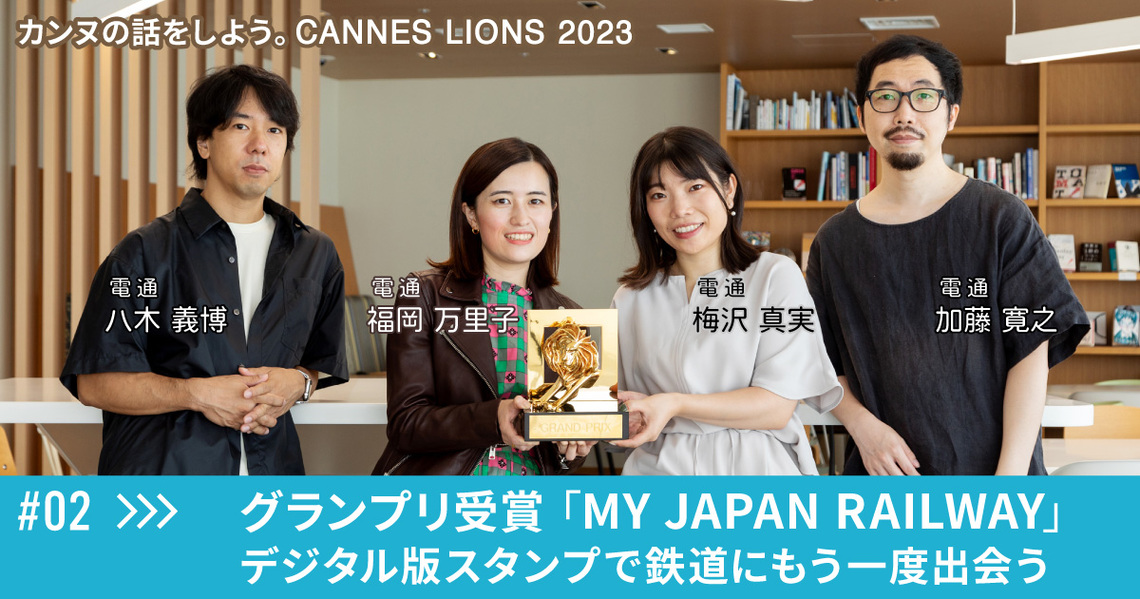The Cannes Lions International Festival of Creativity took place in Cannes, France, from June 19th to 23rd. How did this world's largest celebration of creativity appear to its creators? Winners, judges, presenters, and creators involved in Cannes from various perspectives unravel the "now" of Cannes through their eyes.

Part 2 features a roundtable discussion with the production team behind "MY JAPAN RAILWAY," winner of the Grand Prix in the Industry Craft category. Their digital yet warm stamps sparked conversation. What lies behind the intricate design and its robust concept? We asked about the behind-the-scenes production.
(The roundtable discussion took place on September 12th)
JR Group / 150th Anniversary of Railway Opening Campaign "MY JAPAN RAILWAY"
A joint campaign by six JR Group companies. Marking 150 years of railways, it aims to deepen user relationships through brand experiences that amplify the joy of travel and affection for railways, while also promoting rail use. The digital stamps, obtainable via a smartphone site when near participating stations, vary in blurriness depending on how they're pressed—like traditional station stamps—and record the date/time and stamp number.
An analog design that evokes affection
──First, congratulations on winning the Grand Prix. The JR Group's 150th Anniversary Campaign "MY JAPAN RAILWAY," involving six companies, received the highest honor in the Industry Craft category. How do you feel about this award?
Yagi: First, I'd like to ask Mr. Umezawa, the railway enthusiast.
Umezawa: Yes (laughs). I've always thought Japanese railways are truly amazing—the station buildings, the trains, the views from the windows—they all have so many captivating elements. So, as a railway fan, I'm incredibly happy that we could share the culture of stations, famous landmarks across Japan, and even hidden gems known only to the initiated with the world.
Fukuoka: Since this project's theme was "Redesigning Japan," I'm also delighted it became an opportunity to share Japan's appeal overseas. Furthermore, I'm thrilled that so many people abroad got to learn about Japan.
Yagi: There were times when maintaining motivation was difficult because we had to create so many digital station stamps. However, I was able to enjoy this work by approaching it not just as designing stamps, but with the mindset of "redesigning Japan's infrastructure." On top of that, I'm thrilled we even won the Grand Prix.
──Now, let's hear about the specifics of the campaign. How does this digital stamp rally work?
Umezawa: GPS devices are installed at stations across the six JR Group companies. When you enter the station area with your smartphone's location services enabled, you can collect that station's digital stamp within the dedicated app. Besides regular station stamps, there are also limited express stamps and Shinkansen stamps. For example, for the "Kamome" on the West Kyushu Shinkansen, you get the "Kamome" stamp after collecting two stamps from participating West Kyushu Shinkansen stations.
Yagi: There are also pins placed at locations that used to be stations but aren't stations now, where you can get commemorative stamps.
Fukuoka: There are also work-related stamps. Designed with respect for station workers, they feature motifs like station staff who used to cut tickets with scissors before automatic ticket gates became common.

When you go near a qualifying station, you can stamp it on the smartphone site.
──How many stamps have you designed so far?
──How many stamps have you designed so far?
Kato: About 600 as of last year, and it's increased to about 900 this year.
Yagi: How many more until all stations are complete?
Kato: Probably about ten years, I'd say (laughs).
──So the design team, led by Art Director Kato, designs each stamp individually?
Kato: Yes. Over ten designers are involved. The design concept started from the idea that it would be fun to make something public, like a station, feel like your own. When considering how to achieve that, I thought you need something like "attachment" to truly hold it within yourself.
Before designing, each designer researched their assigned station thoroughly. They absorbed knowledge like, "This station has this history," or "This culture is deeply rooted here."
When actually designing, motifs were chosen based on this research. However, since computers can create anything, the stamps risked becoming bland and impersonal. So, we designed the stamps to foster affection through unique characteristics like their inherent blurriness and analog elements.
Yagi: When you stamp something and think, "Oh, it smudged!" or "It came out too dark," that moment of emotional connection is also the moment the stamp becomes yours. You could even say it becomes a part of you. That's precisely why we focused on details like designing them to look intentionally smudged.
Fukuoka: Each person records stations within their own smartphone. By doing so, memories of each station are recorded. And that connects to collecting Japan itself. Since everyone's Japan—their "MY JAPAN"—is different, the title became "MY JAPAN RAILWAY."
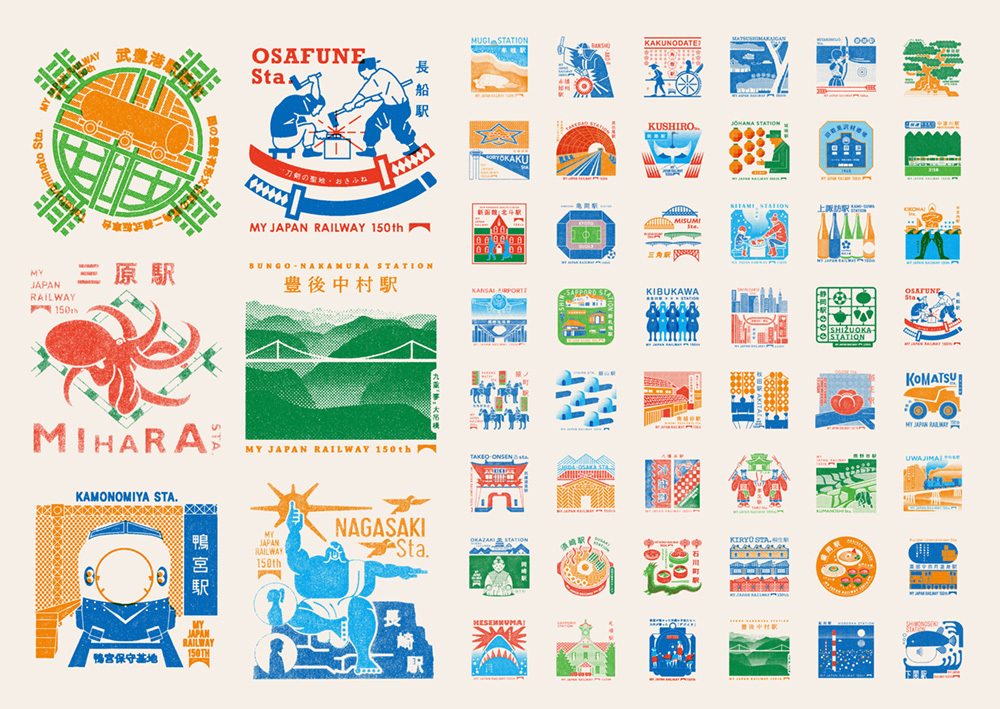
The total number of stamps available to collect at JR Group stations nationwide exceeds 900.
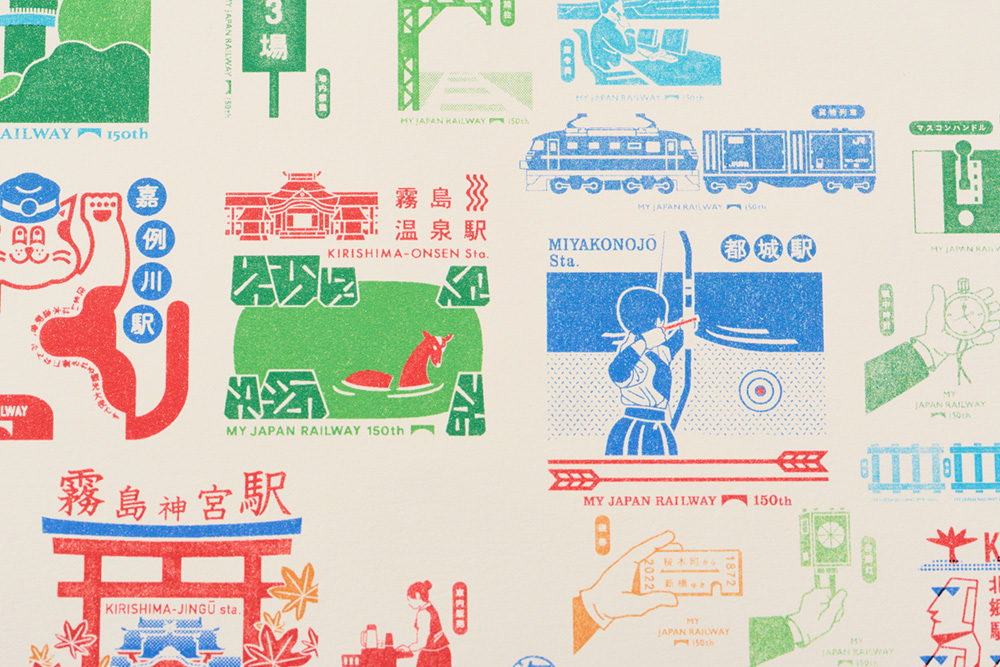
The intensity of the stamp changes the degree of blurring, and the date/time stamped and the order in which it was stamped are also recorded.
Rediscovering the value of railways
──How did the idea for a digital stamp come about?
Yagi: 2022, the 150th anniversary of Japan's railway opening, coincided with the COVID-19 pandemic. Large gatherings and physical stamp rallies were difficult to hold. But a digital stamp could reduce contact risks and be completed entirely on one's own. Once we decided on a digital stamp, we pondered its image and arrived at something digital yet warm.
You know how some local stations have notebooks where you can freely write messages? You get this sense of people connecting through the station. I thought it would be great to achieve that digitally. You could call it "gentle digital." Some young people fall asleep while still connected on LINE, but I felt that sense of security from being connected is something people need in this era.
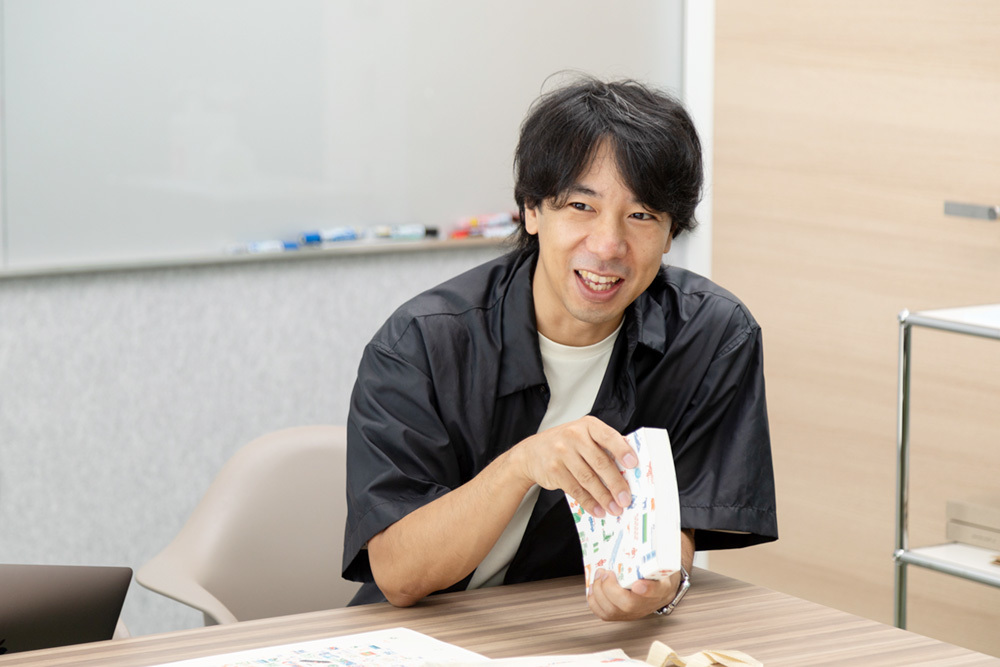
Yoshihiro Yagi, Executive Creative Director at Dentsu zero . Born in Kyoto Prefecture in 1977. Develops diverse creative work through non-verbal visual communication, including corporate and product branding and advertising campaigns. Major projects include JR East Japan's "Get Back, Tohoku.", Honda's "Human! FIT", and Ezaki Glico's "Pocky THE GIFT". Awards include Cannes Design Lions Grand Prix, One Show Best in Design, D&AD Yellow Pencil ×6, JAGDA New Artist Award, ACC Grand Prix, Keizo Saji Award, and many others. Member of Tokyo Art Directors Club, Visiting Professor at Kyoto University of the Arts.
──I hear you thoroughly debated the significance of railways when planning this campaign.
──I hear that when planning this campaign, you all thoroughly debated the very purpose of railways.
Yagi: I imagine people were incredibly moved when railways first opened 150 years ago. Back then, walking or riding horses were pretty much the only ways to get around. Nowadays, we almost unconsciously tap our cards at the gates and use trains as a matter of course, making it hard to appreciate their value as a means of transportation.
But the desire to visit someone or deliver something has always existed within us. I thought that by consciously appreciating the value of travel—something we now take for granted—we might rediscover a sense of happiness.
Kato: Japan's railways connect the entire country, allowing you to go anywhere. That's truly remarkable, isn't it? No other country in the world has such an extensive railway network, connecting city to city, person to person. I wanted to convey just how truly wonderful that is.

Hiroyuki Kato, Art Director, Dentsu Inc. Creative Planning Division 1. Born in Gifu Prefecture in 1984.Believing in the power of graphic design, he directs corporate and product branding, campaigns, and more. Major projects include WILLER TRAINS "Kyoto Tango Railway," Imanishi Sukehiro Classroom, and the Ariake Arena opening project. Awards include ADFEST Gold, LIA Gold, D&AD Wood Pencil, One Show Merit, NAMI Concours Gold, Dentsu Advertising Award Grand Prize, and TOKYO MIDTOWN AWARD Special Jury Prize.
Yagi: That kind of railway charm is something you don't really notice. Living in Tokyo, you usually only think about the stations in the suburbs, but actually, there are many stations connected along that same line. I remember starting the stamp design while imagining that.
──The combination of an app using digital technology and stamp designs that recreate analog charm is truly exquisite. Was that aspect particularly recognized at Cannes?
Yagi: Yes. Honestly, this year's Cannes felt less about high-tech or trendy things and more about entries that genuinely aligned with the brand.
This digital stamp doesn't use particularly advanced technology either. The stamp itself is graphic design, and smartphone apps aren't rare these days. It's really a simple structure.
However, I believe what was appreciated was how we communicated what a company providing social infrastructure like railways should do, and how we envision the future—not through explanation, but by appealing to senses and emotions through the synergy of analog and digital.
Umezawa: JR Group's customers span a wide age range, from newborns to those over 100 years old. Therefore, this digital stamp wasn't aimed at a specific generation; we aimed for participation across all age groups. As a result, I believe it became something loved by everyone.
A stamp that embodies the sentiments of many people
──This was a joint campaign by six JR Group companies. Were the individual designs proposed to each company separately?
Umezawa: Yes. We proposed designs to each company directly—JR Kyushu for stations in Kyushu, JR Shikoku for stations in Shikoku, and so on.
Kato: We conducted very thorough research, decided on a motif thinking "This is it!", and made our proposal. However, JR also has strong feelings about each station, so there were times when they'd say "This motif might not be right," leading to several rounds of back-and-forth.
Umezawa: Of course, JR has deep feelings for their stations, but they also carefully gathered the sentiments and intentions of the surrounding municipalities and facilities. So, these stamps truly embody the collective thoughts of many people.
──What kind of reactions did the digital stamps get from the public?
Yagi: We've noticed an increase in station-related posts on social media. People don't usually share much about stations, do they? But the digital stamps have become a catalyst for people to talk about stations as a subject. And it's not just railway enthusiasts; it's reaching others too. It's been nearly a year since the campaign started, and we hope to continue broadening its appeal.
Kato: From my own experience, having this app makes you think, "If I go to the next station over, there might be a stamp," and it encourages you to take that extra step.
Fukuoka: Even at stations I've visited several times before, seeing the stamps makes me think, "Huh? This place is famous for ◯◯?" or discover things about the area I never knew before. That's part of what makes it interesting.
Umezawa: Among my railway enthusiast friends, collecting stamps itself becomes the purpose of their train trips. Some have even circled Shikoku just to get its stamps. We've even received feedback from participants telling us, "I traveled around Japan to collect all the stamps!"
Yagi: Just like understanding baseball rules makes the game more enjoyable, I hope people will learn about the digital stamp system and have fun with it. Railway enthusiasts research ahead—figuring out which stations have what stamps, or buying ekiben at a particular station—and that's how they enjoy it. I think that kind of time spent is truly enriching.
Umezawa: We have "railway photographers" and "railway enthusiasts," so why not have "stamp enthusiasts"? I have a feeling a new culture could emerge (laughs).
──Finally, how do you feel about working with this team?
Fukuoka: It was incredibly demanding, but I really enjoyed the fact that we met once a week for two hours, had open and candid discussions, and engaged in direct interactions. With this kind of work, if it were only online communication, we might have ended up dividing tasks and it could have felt more like just "work" in many areas. I think it was thanks to this team and our approach that we could think broadly and deeply about things without narrowing our perspective.
Also, it was really great that we didn't take a rigid stance like, "I'm a copywriter, so I only need to think about copy." Instead, everyone contributed opinions and ideas as creative professionals, transcending job titles.
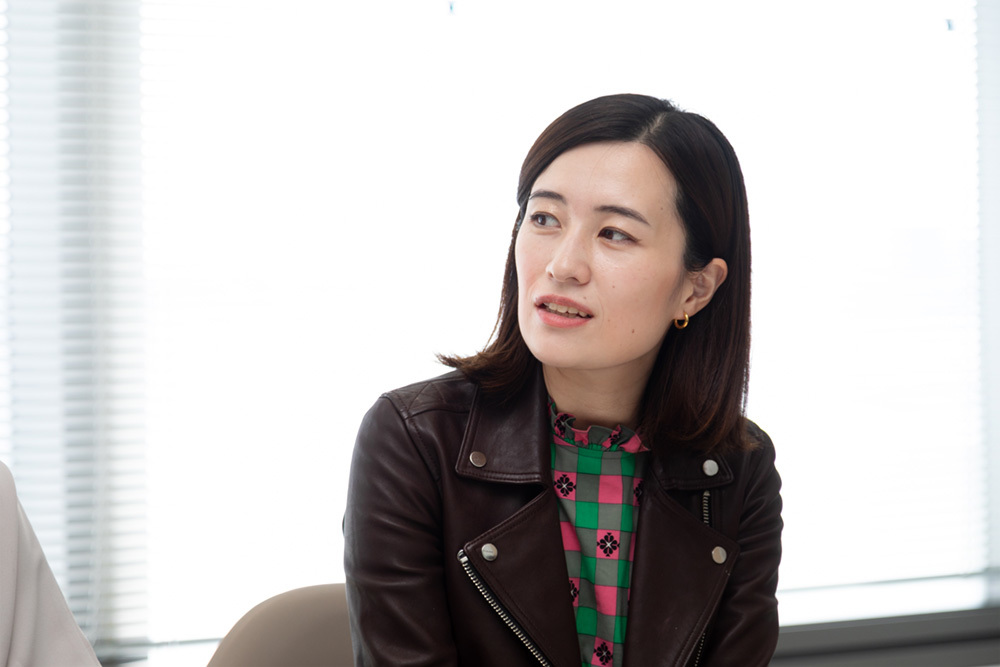
Mariko Fukuoka, Copywriter , Dentsu Inc. Creative Planning Division 1. Born in Tokyo in 1989. Engages in copywriting and concept creation, valuing a focus on a brand's essence and capturing the spirit of the times.Major works include Ad Museum Tokyo's "Beautiful Mutations" and Isehan's "Face Recruitment, We're Starting." Awards include Cannes Lions Grand Prix, One Show Gold, Spikes Asia Gold, ADFEST Gold, TCC Newcomer Award, ACC Award, and Newspaper Advertising Award.
Umezawa: As a member of the BP (Business Production) Bureau, I was also allowed to participate in the weekly two-hour creative meetings, which provided me with invaluable experience.We'd look at station materials and design drafts together, debating back and forth while moving forward. Opinions sometimes clashed, but through repeated dialogue, I felt the work steadily improving. I take pride in believing BP members understand the client best, and I learned the importance of having the courage to actively engage in meetings as a BP member. And since we ultimately won Cannes, it's a project I'll never forget.

Mami Umezawa, Account Lead, Business Producers Division 19. Born in Tokyo in 1994. Joined current position after working at a web-based advertising agency. Involved in various JR East Japan promotions. Currently focuses on launching campaigns and devising strategies to solve various challenges, primarily centered around JR East Japan's Suica and tourism mobility.
Yagi: That's right, when we started this project, we said we'd make it one we'd never forget. As everyone gets busier with different projects going forward, we might forget past work, but this one will surely stay in everyone's memory.
Kato: It became a project we built together as a team—a job none of us will ever forget!
Yagi: Our work is like climbing Mount Everest. It's tough along the way. But once you reach the summit, you see an incredibly beautiful view. So, all we can do is keep saying, "If we push through here, we'll see that great view."
Kato: And we did see that beautiful view, didn't we?
Umezawa: Though we were running out of oxygen partway up (laughs).
Everyone: None, none (laughs).
"MY JAPAN RAILWAY" Staff List
ECD: Takuma Takasaki (zero)
CD: Yoshihiro Yagi (zero)
AD: Hiroyuki Kato (1CR Planning Bureau)
AD: Nanae Ishikawa (5CR Planning Bureau)
AD: Asuka Yamamoto (5CR Planning Bureau)
CW: Mariko Fukuoka (1CR Planning Bureau)
CW: Mina Sugioka (1CR Planning Bureau)
BP: Naoto Ikegami (19 Business Production Bureau)
BP: Mami Umezawa (19 Business Production Bureau)
BP: Jun Maeda (19 Business Production Bureau)
"MY JAPAN RAILWAY" won Grand Prix awards one after another at major awards held from 2023 to 2024, including the Cannes Lions.
Awards where it won a Grand Prix (or equivalent):
Cannes Lions 2023, LIA 2023, Spikes Asia 2024 (3GP), ADFEST 2024 (4GP),Clio Awards 2024, ADC 2024, One Show 2024, D&AD 2024 (Black Pencil), MAD STARS 2024 (3GP + GP of the Year), Gerety Awards 2024
(as of December 2024)

Trophies from awards won by "MY JAPAN RAILWAY" in 2023–24






